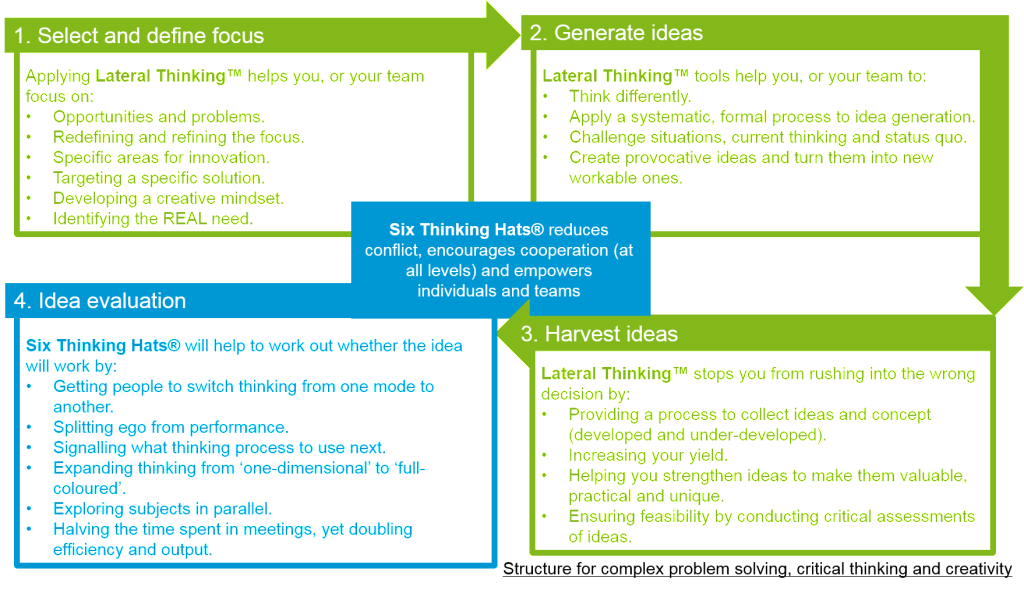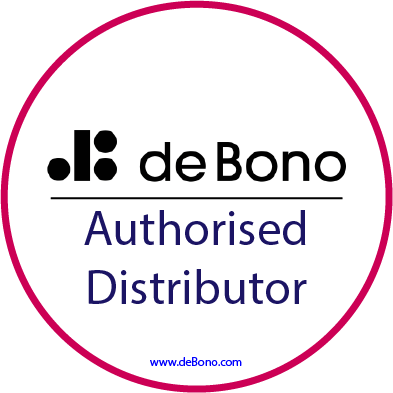So, ‘innovation is a part of your culture’ and you have accepted that ‘change is inevitable…’ You have set your focus and generated fresh, fast and on-demand ideas, so what next? Do you just pop them in a box somewhere and forget about them? A lot of organisations do…
Critical thinking and evaluating ideas
The reason why most ideas fail is because there is no structure to evaluating them or implementing them.
Our roadmap of complex problem solving, critical thinking and creativity focuses on four areas for results:
- Step 1: Selecting and defining focus.
- Step 2: Generating Ideas.
- Step 3: Harvesting Ideas.
- Step 4: Idea evaluation.
This article will explore Edward de Bono’s Six Thinking Hats®, powerful for idea evaluation and meetings. This world renowned management tool actively shortens meeting times, reduces conflict, encourages cooperation (at all levels) and empowers individuals and teams.
Exploring subjects in parallel
Parallel Thinking focuses on using the same thinking tool at the same time. Each of the Six Thinking Hats® represent a different type of thinking where focus is split in specific directions:
- Blue Hat – Thinking about the rules, focus and agenda…
- White Hat – Let’s understand the facts?
- Red Hat – What emotion and intuition are you feeling?
- Black Hat – What are the bad points?
- Yellow Hat – What are the good points?
- Green Hat – Time to get creative…
“Use in current project for improvements identification”. Business Improvement Analyst, Investment Management
Switching thinking from one mode to another
Six Thinking Hats® helps you to highlight the best ideas by wearing six coloured hats consecutively. As participants wear each hat, at the same time, they will think in a specific way with discipline. For example: Red Hat, focuses on the feeling, intuition and fears. Your participants put forward their thoughts without fear of judgement, so you include everyone, not just those who shout loudest. You’ll expose all of the aspects and be able to move from emotional to factual without conflict or delay.
Splitting ego from performance
Isn’t it annoying when people constantly focus on the negatives? Often bringing the group down and damaging constructive discussion? Pop on your ‘Black Hat’… This actively allows critical thinking about the downsides and risks of implementing the ideas. The trick is not to overuse it. The Black Hat shifts people from negative to positive, everyone gets to speak and no-one feels left out.
Expanding thinking from one-dimensional to full-coloured
One dimensional thinking is useful when looking at something that is single or linear. Pointing out faults may lead to some small improvements but misses the bigger picture of what the challenge actually is. Sometimes people even withhold information that does not ‘support’ their ‘argument’.
Most of the challenges we face are complex and have multiple factors. Full-coloured thinking provides the process and discipline to be able to focus effectively, going beyond the obvious by not missing alternatives or new ideas.
“We’ve found that technical teams (IT Teams or logical thinkers) benefit from this framework, it’s something that they feel comfortable implementing as it’s easy to understand across all levels and not viewed as weird by the rest of the organisation.” Managing Director, Business Services
Signalling what thinking process to use next
Ordinarily we try to do too much when we are thinking. We’ll be juggling information, judging it and formulating solutions. When you change from one hat to another, you change from the thinking mode indicated by that hat to the thinking mode indicated by another. This provides a framework that breaks down the thinking into pieces that ensure thorough investigation into what matters, without promoting conflict or alienating other people’s views.
The Blue Hat wearer keeps control and encourages the best thinking from all meeting participants, standing back and facilitating the session. A very important role that keeps time; moves the group through the hats; focuses and refocuses thinking; and calls for decisions to keep the group on track.
“It just challenges the way you think about/and in certain situations. It forces you to make changes to one’s traditional way of thinking” Financial Controller, Information Technology
Halving the time spent in meetings, yet doubling efficiency and output
Every organisation has members of the team who constantly talk over everyone, causing conflict. You may even have senior management dominating every discussion. You need to change the requirement from adversarial to Parallel Thinking. It reduces arguments and keeps your group meeting on track by encouraging attendees, even the quietest, to introduce their thoughts in parallel with others. By making this change you’ll be removing peoples need to attack other ideas and defend their own – resulting in consensus on decisions and faster buy in!
Talk to us about how we can help organisations like yours to improve internal creative thinking, using two key creative thinking and idea generation workshops:




